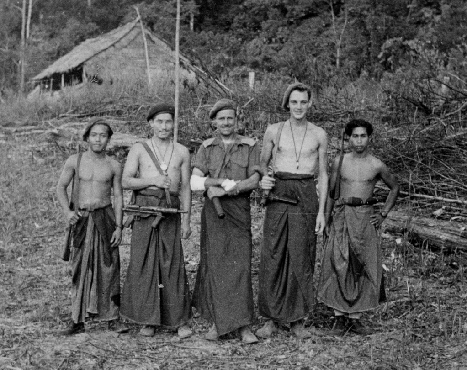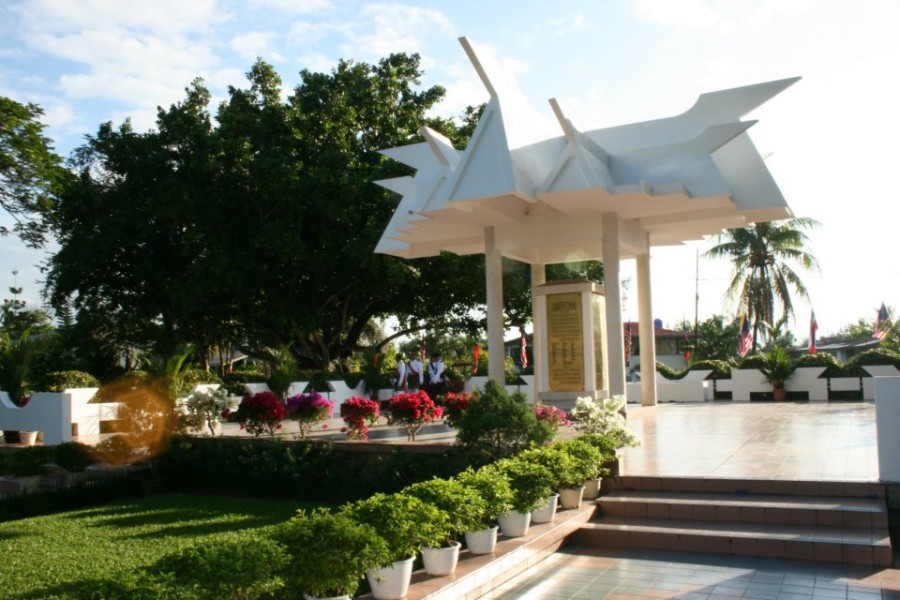Albert Kwok Fen Nam: The Sarawakian Doctor Who Fought The Japanese Army Using A Parang
He led a group of 300 fighters called the 'Kinabalu Guerrillas' to launch an attack on the Japanese army.
Can you imagine a doctor fighting off Japanese soldiers using guerrilla tactics?
That's what Albert Kwok Fen Nam did, and he did it in a truly Malaysian way — using a parang!
The doctor from Kuching, Sarawak was born in 1921 to a dentist father. According to Borneo Oracle, Kwok's father sent him to China when he was just 12 years old to study Chinese medicine.
As China and Japan have been enemies for a long time, Kwok's anti-Japanese army spirit is believed to be stemmed from his stay in the country.
The 19-year-old returned to Kuching in 1940 and on 15 May 1941 he opened his own traditional medicine clinic in Jesselton (now Kota Kinabalu). By this time, the Japanese army had begun the occupation of Borneo.
Kajo Mag said that Kwok lived with his sister and her husband while in Jesselton, whereas the rest of his family were believed to be in Kuching.
Still, his practice was very successful and was said to be quite popular not only in Jesselton but all over North Borneo (now Sabah) and the Philippines.
Albert Kwok Fen Nam, the Sarawakian doctor who formed an anti-Japanese army group called the 'Kinabalu Guerrillas'.
Image via MySabahHowever, everything changed when the Japanese army began its occupation of North Borneo during the early years of World War 2 (WW2)
The Japanese occupation somehow caused the stock of drugs to decline so Kwok had to treat his patients with a limited supply.
His decision to fight the Japanese army was further cemented in his mind on 13 June 1942, merely a few weeks after the occupation, when the Japanese soldiers circulated a decree stating, "Let the Chinese not forget that a single decision of the Japanese Supreme command is sufficient in order for them to be seized and killed."
This fueled Kwok to create a Japanese army resistance group and put a stop to their atrocities.
Kwok sought the help of a Filipino iman (religious leader) named Marajukim, to learn the art of guerilla fighting. Together they travelled to Sulu and learnt the skills of resistance movement under the command of Filipino Lieutenant Colonel Alejandro Suarez.
He then returned to Jesselton with a high determination to liberate North Borneo of the enemy's occupation. Once he arrived, he contacted the Oversea Chinese Defence Association (OCDA) to request for medical equipment and cash donations for the support of the resistance movement.
Once again, in June 1943, he travelled with Marajukim to the Philippines. Through the mediation of Suarez, he met with the representatives of the US army and was appointed Lieutenant on 1 July 1943.
On 21 September 1943, Kwok returned to North Borneo and established his own resistance group called the 'Kinabalu Guerrillas'
The group consisted of about 300 North Borneo people of various ethnicities and religions. Local leaders such as Jules Stephen (Kadazan), Mustapha Harun (Bajau), Commander Ali, and many others united with Kwok to combat the Japanese army.
They were all trained by the Philippine military forces and even by the Commonwealth soldiers themselves. One such prominent soldier was Lieutenant Colonel Francis George Leach 'Gort' Chester, who was a British army member of the Z Special Unit.
Chester had put his undercover skills to use and silently pre-planned everything with Kwok and other local leaders under the Japanese army's noses. It is believed that this was why the Kinabalu Guerrillas' attack was unexpected.
One of the intelligence reports that Kwok received was that 2,000 young men would be forced to join the Japanese army to be used as labourers and young women would be used as the Japanese army's sex slaves.
Lieutenant Colonel Francis George Leach 'Gort' Chester (centre) with Operation Agas's AGAS 1 Party.
Image via WikipediaSo, on the eve of 10 October 1943, Kwok and 300 Kinabalu Guerrilla members began their attack — dubbed as the 'Double Tenth Revolt' — against the Japanese army in Tuaran and Menggatal
The next day, 10 October 1943, the Kinabalu Guerillas entered Jesselton and attacked from the seaside where there were several Japanese soldiers' warehouses. They burned the warehouses to ashes.
Kwok led a group of 100 members for a land attack, while the Suluk and Bajau members attacked from the sea.
Although they did not have many firearms like the Japanese army, their attack resulted in nearly 100 Japanese soldiers being killed mainly by parangs, bujak (spears), and keris (daggers).
According to Soscili, the reason why they did not use guns was to avoid the firearm and ammunition tax.
Following the success, Kwok and the Kinabalu Guerrillas managed to temporarily take over control of Tuaran, Menggatal, and Jesselton.
As a result of losing this attack, the Japanese army called for backup from Kuching and managed to chase the Kinabalu Guerrillas out of Jesselton and Tuaran three days later
The Kinabalu Guerrillas were forced to split into smaller groups to retreat into the hills of Menggatal as they were ill-equipped against the increased number of Japanese soldiers.
The war continued for more than two months, during which the Japanese army used various tactics to catch every member of the Kinabalu Guerrillas. Their dirty tactics included torturing families of the group regardless of young or old age, men or women.
The Japanese army also threatened to execute 400 civilians in Shantung Valley, Penampang if the Kinabalu Guerrillas did not surrender.
Unbearable to bear seeing their families being tortured, plus the lack of food assistance and lack of modern war knowledge, the Kinabalu Guerrillas surrendered on 19 December 1943.
After being jailed at the Batu Tiga Prison (now Kota Kinabalu Prison) for a month, Kwok and 176 Kinabalu Guerrilla members were beheaded on 21 January 1944 in Petagas, Putatan.
Some sources say that some of these people were not beheaded, instead, they were either shot with a machine gun or stabbed to death with bayonets.
The rest of the Kinabalu Guerrillas were sentenced to prison in Labuan with no news of their conditions until 1949, when their bodies were found in Labuan. They were transferred to be buried in Petagas, which became the final resting place of all the Kinabalu Guerilla members.
It is said that only 14 people of the Kinabalu Guerillas were actually kept alive after Japan surrendered in Borneo as a result of the Nagasaki and Hiroshima bombing by the Allied forces in 1945.
Kwok was only 23 years old when he was cruelly beheaded by the Japanese army
But the story of his bravery and spirit to fight the Japanese army, armed with only parangs, spears, and daggers — even briefly managing to win the war — is one that should be remembered by all!
His name along with the rest of the Kinabalu Guerrilas' are now engraved at the Petagas Memorial, Sabah.


